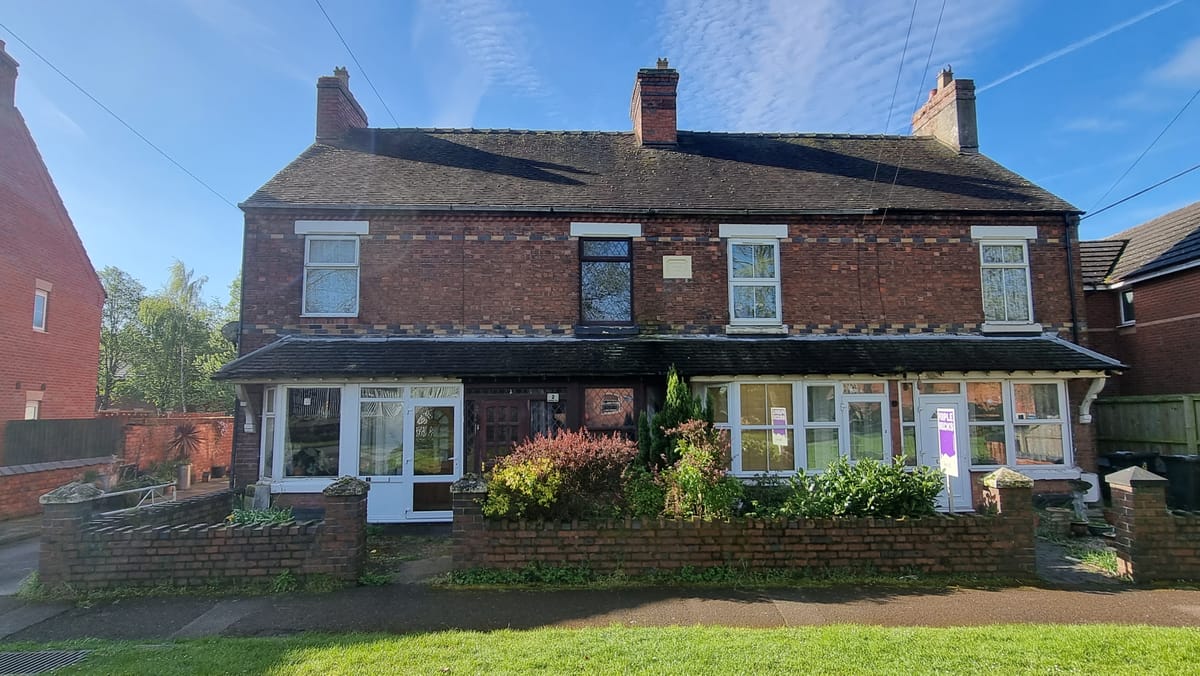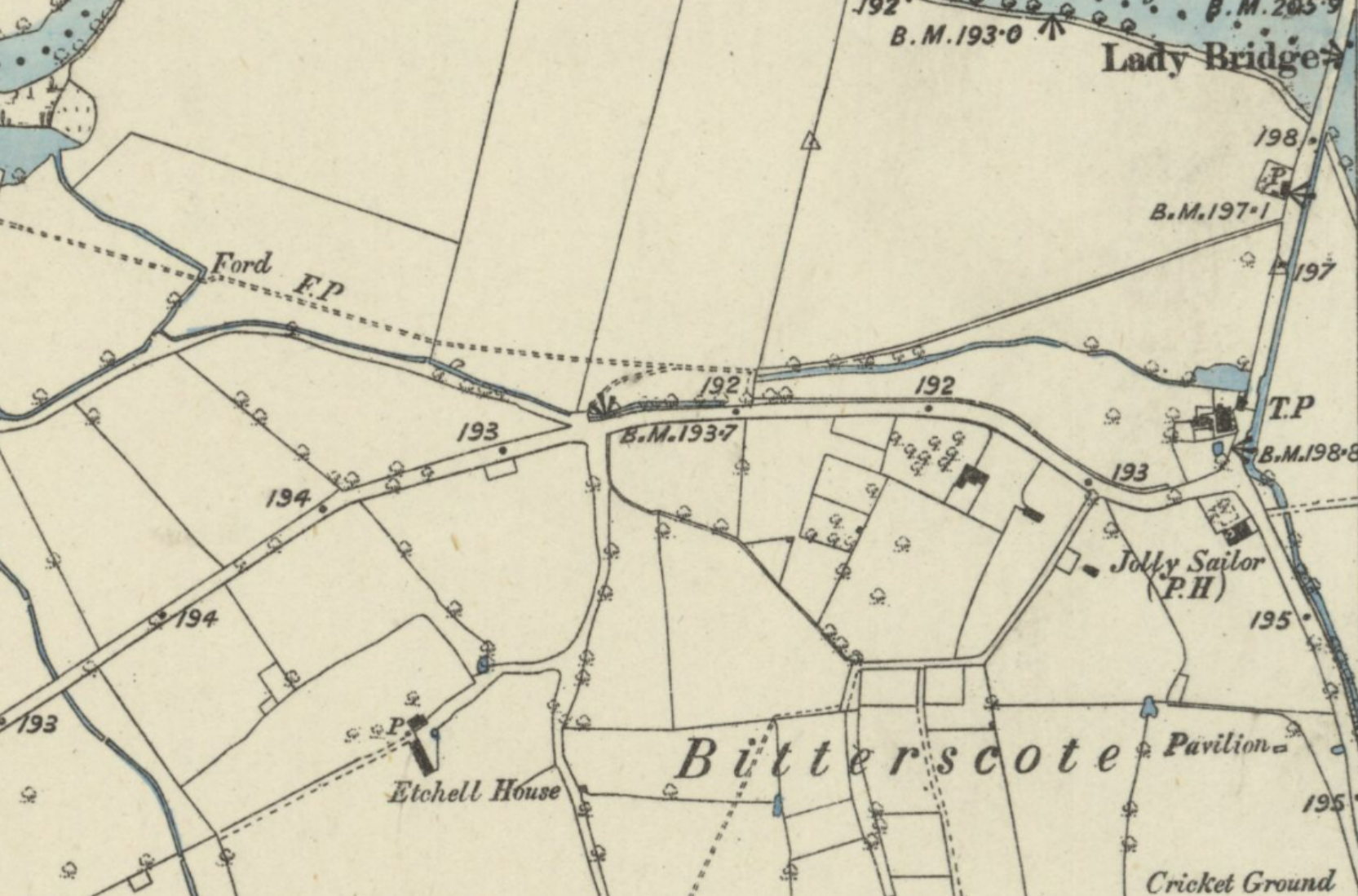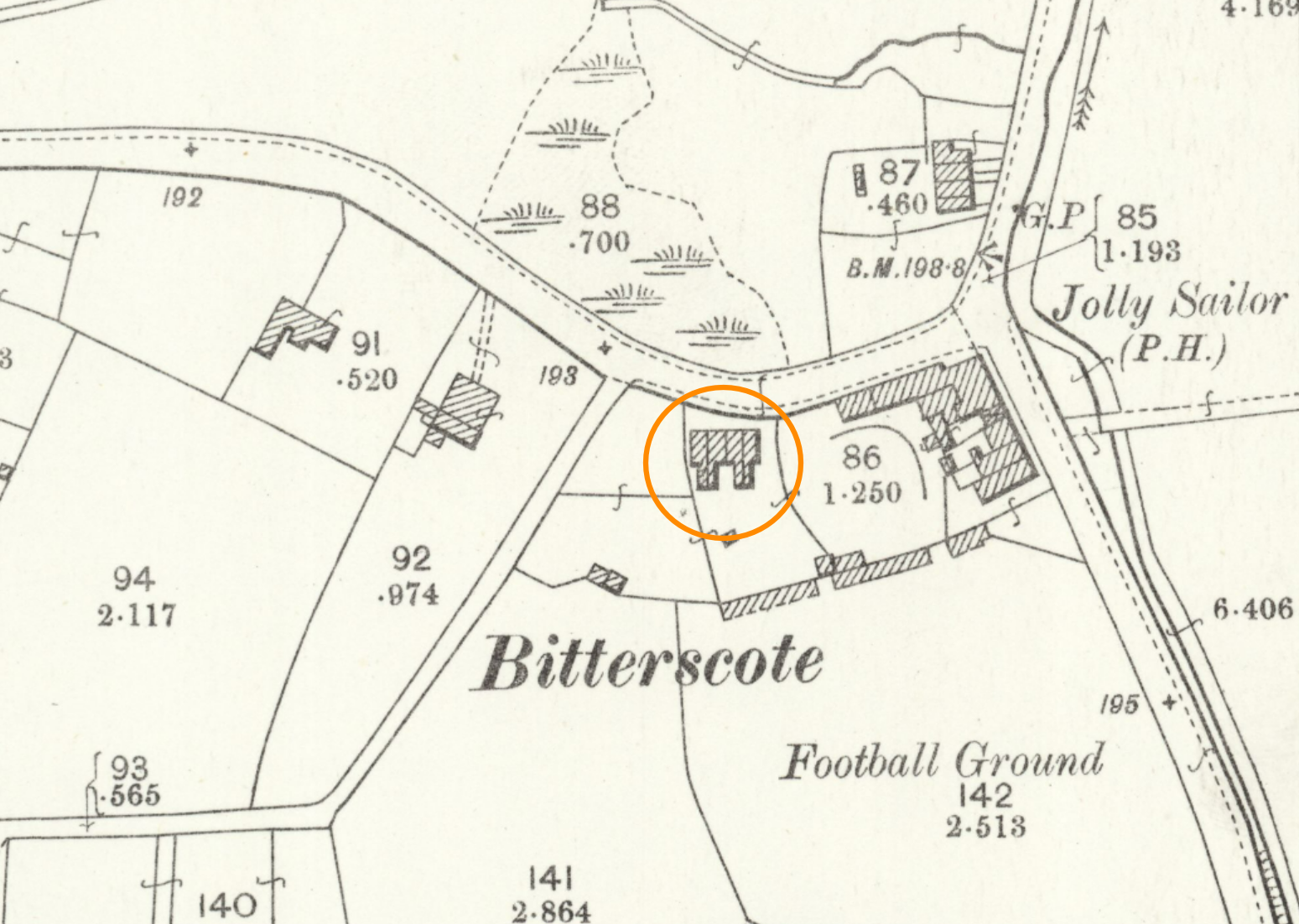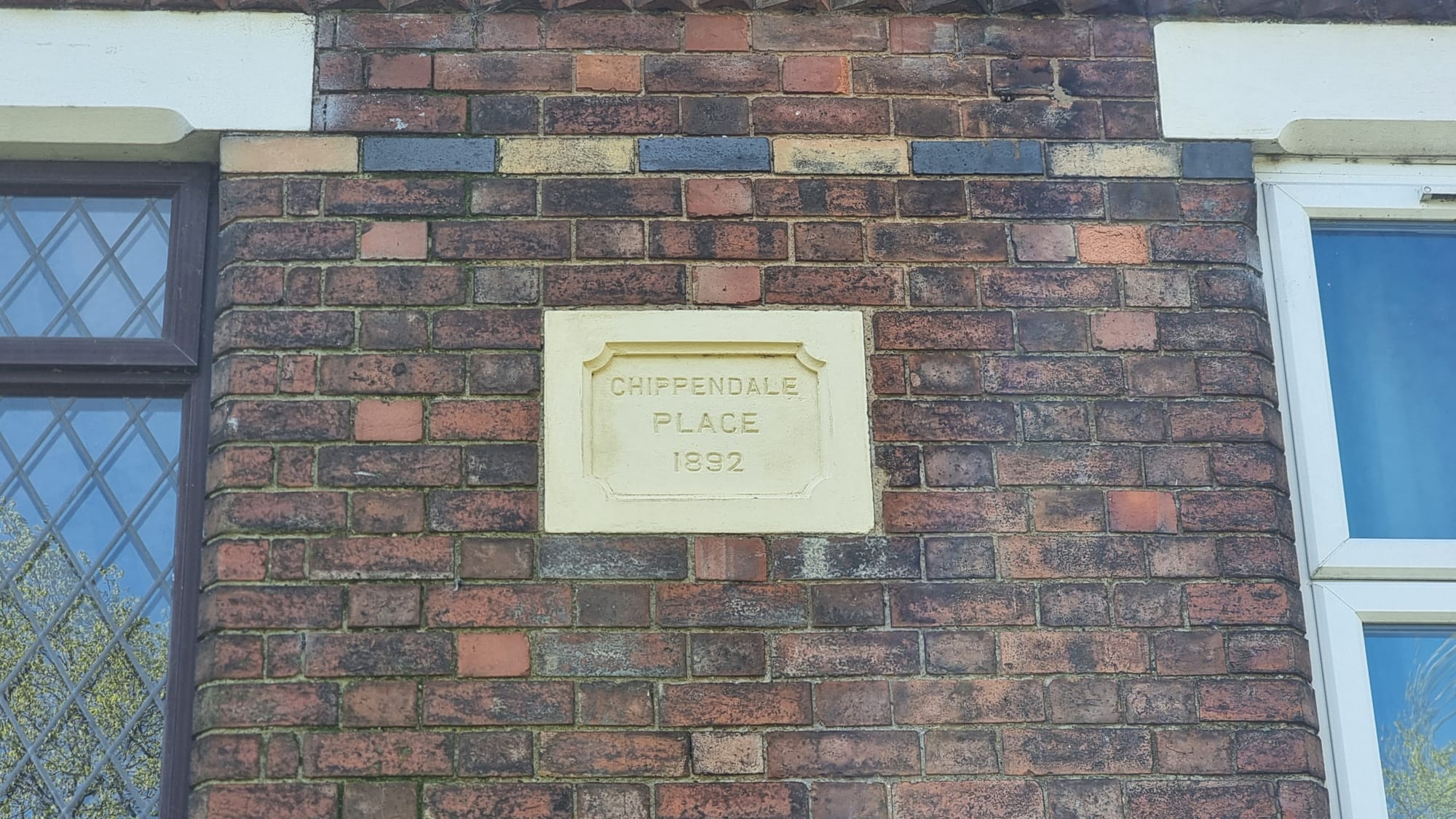Chippendale Place, Tamworth
Two of the four properties in Chippendale Place have been up for sale recently, so I thought it would be interesting to share how I started to put together a house history.

Chippendale Place is a small terrace of four cottages at the eastern end of Bonehill Road, Tamworth. Two of the four properties have been up for sale recently, so a couple of weeks ago I thought it would be interesting to dig into their history, especially since they are the only remaining Victorian properties at this end of the road. This little 'exploration' is quite typical of my starting point for a house history, so I thought it would be interesting to share my findings so far.

Let's begin by orienting ourselves, as the roads in this area look very different today. In the map above, Lady Bridge is a fixed landmark beloved by local residents for centuries. It was rebuilt in 1796, after floods destroyed its predecessor, and it was widened in 1840. The road running south from Lady Bridge past the Jolly Sailor Public House is Fazeley Road. It still exists but it is now a no-through road, which is blocked off to the south of this map. Etchell House would have been roughly where the Jolly Sailor roundabout is today. The road running from the centre of the map almost directly west is Dunstall Lane. It leads to Dunstall Farm, which is off the map to the west. Etchell House and Dunstall Farm were part of the Peel Estate holdings which were sold by auction in 1918-19. Sale documents are kept in the National Archives. Dunstall Farm still exists.
Newspaper Cuttings - mostly about floods and sewage
I have collected together lots of references to the eastern end of Bonehill Road from the Tamworth Herald. These form a picture of life in the area around the time when Chippendale Place was built (1892).
There was no water supply to the west of the Jolly Sailor before 1887. In September 1886, after a lengthy discussion on matters of health and finance, it was resolved to extend the mains water supply from the Jolly Sailor along the Bonehill Road to the cottages adjoining Bonehill nurseries (near Brakes). This project was completed by March 1887.
In 1889 calls were made to address a worsening problem on Bonehill Road - the council had been using part of a meadow adjoining the road as an unofficial tip. I don't know the exact location, only that it was "on the lower part of the Lady Meadows". The tip was described in the Herald.
For some time past, the Corporation of Tamworth have used a portion of one the meadows adjoining the Bonehill Road, for the deposit of rubbish, which, in this hot weather, gives off a stench said to be sufficient to cause grave fears of some epidemic arising from the decomposition of matter. This week the horrible stench arising from portions of the deposited rubbish has been almost unbearable. The water flow has been interfered with, and, at the present time the effluvia from stagnant water is very offensive. To use such a place for a tip for ashes and house refuse, cannot he regarded as evidence of practical forethought, or sound wisdom on the part of the Corporation, and the Rural Authority, in whose district the nuisance exists, should be asked to explain why they have allowed the nuisance to be created.
At other times the fields adjoining Bonehill Road were used in much more pleasing ways, for example for a football contest with entertainment by the Tamworth Volunteer Band, in 1890.
In 1891 the Herald was still publishing complaints about the tip. They also spoke of the ongoing flooding in Bonehill Road.
A few days continuous rain and the Bonehill Road is simply impassible to pedestrians [...] Apart from the inconvenience the frequently flooded state of the road creates, there is a strong element of danger attending the practice of walking the railings order to avoid the flooded road. Children might easily overbalance themselves and, falling into the yet unfilled portion of the ditch that skirts the roadway, meet with an untimely death.
JB of Bonehill Road responded:
Years this was considered one of the prettiest approaches to the town, but those who control the affair of the Rural and Urban districts have jointly turned the place into a quagmire, and the ditch in the lower meadow into what might properly be described as a dangerous cesspool.

Notice the vast extension to the Jolly Sailor between the two maps (1882 and 1890). Chippendale Place was built in 1892, as can be seen on the plaque between number 2 and 3. I have not yet identified the buildings on plots 91 and 92, and it is not yet clear to me whether they were houses or agricultural buildings.

I have not found any information on the builders of Chippendale Place, but I imagine the cottages were built as an investment. The freehold seemed to remain in the same ownership until 1945, and I believe that the cottages were tenanted throughout that time.
In January 1895 the flooding continued in Bonehill Road, and must have gravely affected the new residents at Chippendale Place:
At Tamworth the flood was seen at its worst on the Fazeley and Bonehill roads. On the latter important thoroughfare the water extended from Bitterscote and Dunstall lanes, both of which presented the appearance of fast running streams, to the Jolly Sailor Inn. The water was several feet deep, and a strong current near the bend of the road made traffic very dangerous. The Fazeley road was almost flooded in its entirety, the only break of the continuous stretch of water being immediately on either side of the White houses. From the fields on the left-hand side, a large volume of water poured into the drain in front of the cottages, flooding the gardens and pigsties. The Fazeley road weir was totally invisible, the only indication of its existence being rustling of the water as it passed over the large stones on the brink of the weir. The Swifts football field [see map] was entirely submerged, and the Athletic Enclosure was also partially flooded. The shrubberies at the back of the Jolly Sailor Inn were also covered, and the Bowling Green there was filled with several feet of water on which a number of ducks soon made their appearance. The flood at Lady Bridge where the Anker flows into the Tame presented a remarkable appearance. The waters rushed with great velocity through the arches, and a wonderful scene was presented on the Lichfield side of the bridge, attracting hundreds of onlookers.
In July 1900 the council again discussed the issues on Bonehill Road:
The Surveyor reported as follows: There is a serious nuisance on the Bonehill Road caused by the sewage from the houses in the neighbourhood of the Jolly Sailor discharging into a ditch by the side of the road. It is a difficult matter to remedy this owing to the ditch being on the same level the river. All that can be done is to have it cleaned out and disinfected. There are several nuisances of this kind in the district which can only be remedied by a sewerage scheme.
The Surveyor reported on his remedy the following month:
The Surveyor reported that in order to remedy the nuisance on the Bonehill road he had found it necessary to have the brook course from below Alders Mill thoroughly cleaned out and deepened, and it would be finished in about another week. When that was done he proposed to pipe the ditch and have it filled in.
In October his reports were not as good:
The Surveyor reported that he had been unable owing to insufficient fall to pipe the ditch of the Bonehill road, but he had made arrangements for the construction of a cesspool which would be periodically cleaned out, and would, to some extent, mitigate the nuisance.
1901 Census
The following is the order of the census, which seems to run from west to east along Dunstall Lane and Bonehill Road. Why, oh why, didn't the enumerator include all the house names and numbers? So frustrating!
- Dunstall House - Thomas Smith, farmer, and family.
- Dunstall Lane - William Brooks, stockman, and family.
- Etchell House - Charles Binnersley, market gardener, and two children.
- Bonehill Road (possibly 4 Chippendale Place) - William Coton, coal miner, and family.
- Bonehill Road (possibly 3 Chippendale Place) - William Henley, machine fitter, and family.
- Bonehill Road (possibly 2 Chippendale Place) - Lucy Hatton, widow, and family.
- Bonehill Road (possibly 1 Chippendale Place) - John Devey, boot trade manager, and family. He had lived in Bonehill Road from at least the previous year, when two ducks were stolen from a pen to the rear of the house.
- Bonehill Road - Henry Edwards, photographer, and family.
- Bonehill Road - William Lock, travelling hawker, and wife.
- Tamworth Road - William Andrews, maltster, and family.
The census continues with four further households on Tamworth Road, then two at Castle Mill, then:
- Jolly Sailor Inn - William Tait, licenced victualler, his wife and two servants.
The census then returns to Tamworth Road.
The Sewer
In August 1901 the local Medical Officer of Health was still complaining about the state of the ditch.
The sewage from the houses near the Jolly Sailor was still a nuisance and a source of danger to those in the neighbourhood of the Bonehill road, where there was a most offensive ditch. This was an urgent matter and one which could only properly be dealt with by the adoption of a system of sewerage which would give facilities for the sewering of the houses and others in the district were so much needed.
In September 1901 the Rural District Council decided to build a temporary sewer across the meadows. Mr Millington was named as the owner of the field.
Work was not completed until July 1902, when arrangements were made to connect the houses to it.
1903 Jolly Sailor
On the death of William George Tait, the freehold of the Jolly Sailor Inn was advertised for auction in January 1903. Two months later there was another flood in Bonehill Road.
Owing to the great amount of rain which has recently fallen, the rivers Tame and Anker overflowed their banks. Several fields are inundated. Part of the Bonehill road was under water.
The same thing happened in October.
1905, auction of property at 1 Bonehill Road
An auction of household furniture took place in the property of Mrs Swinfield who was leaving the area. The scale of her belongings seems to great for this to be 1 Chippendale Place.
1908
Each year there seemed to be more flooding, then in May 1908 there was a particularly bad flood.
A terrific thunderstorm swept over Tamworth and district early Sunday morning. About midnight on Saturday lightning was frequently seen, and this was followed in the succeeding small hours by rumblings of distant thunder. As time wore on the lightning became more vivid, and the thunder increased in heaviness and frequency. About three o'clock the full force of the storm came, and continued till shortly after four o'clock. The remarkably brilliant flashes of lightning, and the exceedingly loud crashes of thunder caused much alarm in many households. Very little rain fell locally until towards the end of the electric storm, when it came down in torrents for a long period. The weight of rain was considerable for the time of its duration, and had the effect of renewing the floods of the previous week, some of which still remained. The levels of the Tame and Anker rose rapidly on Sunday, and on Monday morning the area of the flood exceeded anything which has occurred since the memorable inundation of December 31, 1900. The water rushed down at tremendous force, and the meadows were speedily submerged. Its rising continued till about 6 a.m., and then appeared to be receding. On the Fazeley and Bonehill roads there was a great depth of water for a considerable distance. The football ground, cricket field, and the bowling green at the Jolly Sailor were flooded. Residents of houses on the Bonehill road were called up at about 4 a.m., and promptly removed the furniture from the lower rooms to places of safety, as it was feared the water would get inside. Fortunately this did not happen.
1908 Sewers
More work was undertaken in 1908. The surveyor reported:
A start has now been made on Contract No. 4 in the Fazeley district, and two gangs are at work, one on the Bonehill road by the "Jolly Sailor," and the other at a point on the Fazeley road about half-way between Fazeley and Tamworth. I have found it necessary to put 50 yards of iron pipes by the "Jolly Sailor," owing to the very bad nature of the ground which had been met with, consisting of running sand together with a large quantity of water. The ground where the other gang are working is of a much better nature, and I hope to able to lay ordinary pipes, or at the most Hassel's patent pipes.
1911 - Census
The following is the order of the census, as it appears after 9 Fazeley Road. Note that this time the census seems to run in reverse, from east to west, apart from numbers 2 and 3. Again, the enumerator does us no favours!
- Bonehill Road (probably 1 Chippendale Place) - Harry Millington, a law clerk who was born in the US, his wife Esther Jane and his son, Sydney, age 6. Harry could have been related to the man who owned the meadow where the sewer was built.
- 3 Bonehill Road - William Henley, stationary engineman for a tape manufacturer, and his sister Mary.
- 2 Bonehill Road - Levi Mitchell, insurance agent, and family. (He had been a grocer on the corner of Lichfield Street and Coleshill Street in Fazeley and went bankrupt in 1909 - he was sentenced to 2 months; imprisonment for fraud in August 1911 age 53). He later lived at 31 Victoria Road and died in 1948.
- Chippendale Place, (possibly 4 Chippendale Place), Bonehill Road - John Marson, police pensioner, and family.
- Etchell House, Bitterscote - Charles Binnersley, banksman at colliery, and family
- Dunstall Lane - James Payne, waggoner, and family.
- Dunstall Farm - T Graham Smith, farmer, and family.
1914 - The Fazeley Weir
One of the principle causes of flooding in Bonehill Road was believed to be the Fazeley weir. In 1914 "W. Henley, 3 Bonehill road, fireman" was one of the signatories of a petition to remove the weir.
1921 Census
- In the 1921 Census the three Millingtons were at 1 Chippendale Place.
- Albert Burdett, his wife Amy, their daughter Irene Lilian, and their son Albert Roy, were at number 2. Sadly Albert Roy died the following year age 2. Albert snr had been living at Willow View, Tamworth Road, Fazeley in 1911. They had moved to Albert Road by 1939.
Snippets of news
- 1921 - John Marson died in a cottage in Chippendale Place. He was a former Inspector of Police in Tamworth. He was 69 years old. In 1901 he had been living in Church Street.
- 1935 - Thomas Milburn lived at 3 Chippendale Place after parting with his wife.
- 1944 - Ann Hatton won a Baby Show prize - she was living at 4 Chippendale Place.
- 1945 - freeholds auctioned - tenants at that time were Millington (1), Baker (2), Bramall (probably 3), and Hatton (probably 4).
- 1947 - Sidney John Baker died at number 2. He was the former landlord at the Jolly Sailor.
- Harry Millington died at 1 Chippendale Place.
A rabbit hole
As you can see, this research is very incomplete, with many working assumptions and unanswered questions. Genealogy is a fascinating rabbit hole and I could easily spend months working on this small area alone. I welcome any further information about these cottages, but I am now concentrating my research efforts on other stories.
